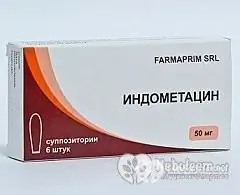- Author Rachel Wainwright [email protected].
- Public 2023-12-15 07:39.
- Last modified 2025-11-02 20:14.
Indomethacin
Instructions for use:
- 1. Release form and composition
- 2. Indications for use
- 3. Contraindications
- 4. Method of application and dosage
- 5. Side effects
- 6. Special instructions
- 7. Drug interactions
- 8. Analogs
- 9. Terms and conditions of storage
- 10. Terms of dispensing from pharmacies
Prices in online pharmacies:
from 18 rubles.
Buy

Indomethacin is a non-steroidal anti-inflammatory drug with analgesic, antipyretic effects.
Release form and composition
Dosage forms:
- Enteric-coated tablets: round biconvex, the color of the tablet core is white or white with a yellowish tinge, the shell is from white to almost white (10 or 30 pcs. In blisters made of aluminum or polyvinyl chloride, in a cardboard box 1, 2, 3, 4, 5, 6, 8 or 10 packs; 10, 20, 30, 40, 50, 60 or 100 pcs. In polymer cans, in a cardboard box 1 can);
- Rectal suppositories: have a torpedo shape, white with a yellow or cream shade, color and a weak specific odor (in a blister strip: 50 mg - 3 or 5 pcs., In a cardboard box 2 packs; 6 pcs., In a cardboard box 1 pack; 100 mg - 5 pcs., 2 packs in a cardboard box);
- Ointment for external use 10%: from dark yellow to light yellow with a greenish tint of color and a specific odor (15, 30 or 40 g in aluminum tubes, or 30 g in a polymer tube, in a cardboard box 1 tube; 10, 15, 20, 25, 30 or 40 g in glass jars, in a cardboard box 1 can);
- Gel for external use 5% or 10%: has a uniform structure of yellow color and a faint smell of alcohol (40 g in aluminum tubes, in a cardboard box 1 tube).
The active substance is indomethacin:
- 1 tablet - 25 mg;
- 1 suppository - 50 or 100 mg;
- 1 g of ointment - 100 mg;
- 1 g of gel - 50 or 100 mg.
Auxiliary components:
- Tablets: potato starch, lactose monohydrate, microcrystalline cellulose, magnesium stearate, povidone;
- Ointment: macrogol 1500, dimethyl sulfoxide, glycerol, macrogol 400;
- Gel: carbomer, macrogol 400, propylene glycol, ethanol 96%, sodium benzoate.
Additionally, the tablets contain a film shell: polysorbate-80, cellacephate, titanium dioxide.
Indications for use
- Systemic use: articular syndrome (including osteoarthritis, rheumatoid arthritis, gout, ankylosing spondylitis), pain in the spine, myalgia, neuralgia, inflammatory processes in soft tissues and joints as a result of injury, rheumatism, diffuse connective tissue diseases, dysmenorrhea; as part of complex therapy for prostatitis, adnexitis, cystitis, infectious and inflammatory diseases in otorhinolaryngology;
- External use: articular syndrome in exacerbation of gout and rheumatism, rheumatoid arthritis, ankylosing spondylitis, psoriatic arthritis, back pain, osteoarthritis, osteochondrosis with radicular syndrome, sciatica, neuralgia, myalgia, inflammatory lesions, tendons and ligaments; post-traumatic inflammation of soft tissues and joints; muscle pain of rheumatic and non-rheumatic genesis;
- Local application: inhibition of miosis during surgery, prevention of inflammatory processes after surgery on the anterior segment of the eye and for cataracts.
Contraindications
The use of all forms of Indomethacin is contraindicated:
- Exacerbation of erosive and ulcerative lesions of the gastrointestinal tract (GIT);
- Hypocoagulation and other disorders of hematopoiesis;
- The period of pregnancy and breastfeeding;
- Age under 14;
- Hypersensitivity to drug components.
It is forbidden to prescribe tablets, suppositories and ointment to patients with the following diseases:
- Aspirin triad;
- Severe liver and / or kidney dysfunction;
- Severe chronic heart failure;
- Severe arterial hypertension;
- Pancreatitis
In addition, rectal use is contraindicated in patients with proctitis, with recent bleeding from the rectum, external - in violation of the integrity of the skin.
It is recommended to prescribe with caution:
Indomethacin in the form of tablets, suppositories, ointments for patients with diseases of the gastrointestinal tract, kidneys, liver in history, epilepsy, heart failure, arterial hypertension, with parkinsonism, immediately after major surgical operations, elderly patients
Gel simultaneously with other non-steroidal anti-inflammatory drugs (NSAIDs), for bronchial asthma, allergic rhinitis, polyps on the nasal mucosa
Method of administration and dosage
The dosage form, dose and treatment period are prescribed by the attending physician based on clinical indications and the patient's condition.
The tablets are taken orally, after meals. The initial dose for adults is 25 mg 2-3 times a day, for 4 weeks. To achieve a therapeutic effect, it is allowed to increase the dosage to 50 mg 3 times a day. The maximum daily dose is 200 mg, with long-term treatment no more than 75 mg.
Suppositories are used rectally, 50-100 mg 2 times a day, with maintenance therapy 1 time a day (at night). The maximum daily dose is 200 mg.
The ointment is applied externally 2 times a day.
The gel is applied in a thin layer to painful areas of the body, and rubbed into the skin with light movements. A single dose for adults corresponds to a strip of gel 4-5 cm long, for adolescents - 2-2.5 cm. The frequency of procedures for 5% gel is 3-4 times, for 10% - 2-3 times a day. Do not exceed the recommended dose of the drug.
Side effects
The use of tablets, suppositories, ointments can cause side effects:
- From the digestive system: discomfort and pain in the abdomen, nausea, vomiting, constipation or diarrhea, anorexia, bleeding, erosive and ulcerative lesions and perforation of the gastrointestinal tract; rarely - stomatitis, intestinal strictures, flatulence, gastritis, jaundice, bleeding from the diverticulum or sigmoid colon, hepatitis;
- From the side of the cardiovascular system: increased blood pressure (BP), edema, tachycardia, arrhythmia, chest pain, arterial hypotension, palpitation, hematuria, congestive heart failure;
- From the nervous system: depression, dizziness, fatigue, headache; rarely - drowsiness, anxiety, convulsions, fainting, peripheral neuropathy, muscle weakness, involuntary muscle movements, sleep disturbances, paresthesia, mental disorders (psychotic episodes, depersonalization), parkinsonism, dysarthria;
- From the hematopoietic system: rarely - petechiae or ecchymosis, leukopenia, purpura, thrombocytopenia, hemolytic and aplastic anemia, disseminated intravascular coagulation;
- Allergic reactions: rarely - urticaria, skin rash and itching, angiitis, erythema nodosum, Stevens-Johnson syndrome, exfoliative dermatitis, hair loss, erythema multiforme, acute respiratory distress, toxic epidermal necrolysis, a sharp decrease in blood pressure, bronchial asthma, anaphylactic reactions, angioedema, pulmonary edema;
- From the senses: rarely - diplopia, orbital and periorbital eye pain, visual impairment, hearing impairment, tinnitus, deafness;
- From the urinary system: rarely - nephrotic syndrome, proteinuria, renal dysfunction, interstitial nephritis, renal failure;
- From the side of metabolism: rarely - glucosuria, hyperglycemia, hyperkalemia;
- Others: rarely - hot flashes, vaginal bleeding, tension and enlargement of the mammary glands, increased sweating, nosebleeds, gynecomastia;
- Local reactions: with rectal administration, tenesmus, irritation of the rectal mucosa, exacerbation of chronic colitis are possible; with external - redness, itching, rash at the site of application.
With prolonged use of the gel, local side effects may appear in the form of burning, redness, itching and rash, skin hyperemia, and the development of allergic reactions.
If signs of undesirable effects appear, you should contact your doctor.
special instructions
The drug should be used with caution if the patient has dyspeptic symptoms.
Simultaneous use with acetylsalicylic acid and other NSAIDs, with diflunisal is not recommended.
Indomethacin is used only in emergency cases if there is a history of allergic reactions to NSAIDs.
The use of the drug must be accompanied by systematic monitoring of the peripheral blood picture, liver and kidney function.
Ointment and gel are applied only to areas with intact skin integrity; they should not be allowed to get on the mucous membranes, including the eyes.
During the period of use of the drug, patients are advised to refrain from all types of activities, the implementation of which depends on the high speed of psychomotor reactions and concentration of attention.
Drug interactions
The drug reduces the effect of uricosuric, antihypertensive and diuretics (saluretics); increases the effect of antiplatelet agents, indirect anticoagulants, fibrinolytics; increases the development of side effects of estrogens, mineralocorticosteroids, other NSAIDs; promotes the growth of the toxic effect of zidovudine.
Concomitant use of probenecid can increase the concentration of indomethacin in the blood.
With the simultaneous use of Indomethacin:
- Glucocorticosteroids, colchicine, diflunisal, ethanol - increase the likelihood of gastrointestinal complications and bleeding;
- Gold preparations, paracetamol, cyclosporin - increase the nephrotoxic effect of indomethacin;
- Cefoperazone, cefamandol, valproic acid - promote the development of hypoprothrombinemia, increase the risk of bleeding;
- Sulfonylurea derivatives - enhance the hypoglycemic effect.
When combined with penicillin, lithium preparations, digoxin, methotrexate, the level of their concentration in the blood plasma increases.
Analogs
Indomethacin analogs are: Indomethacin Sopharma, Indomethacin-Acri, Indomethacin 50 Berlin-Chemie, Indomethacin 100 Berlin-Chemie, Indomethacin-Altpharm, Indomethacin-Biosynthesis, Indovis EC, Metindol Retard, Adolor, Diclofenac, Aelorantal, Dikentartal, Dikentartal, Ketalgin, Ortofen, Ketorol, Rapten, Naklofen, Ketanov, Piroxicam, Ibuprofen, Nise.
Terms and conditions of storage
Keep out of the reach of children. Keep:
- Tablets and gel: in a dark place at temperatures up to 25 ° C;
- Suppositories: in a dry place at temperatures up to 25 ° C;
- Ointment: in a dark place at a temperature of 5 to 30 ° C.
Shelf life: tablets - 3 years; suppositories, ointment, gel - 2 years.
Terms of dispensing from pharmacies
Tablets and suppositories are available with a prescription, gel and ointment are available without a prescription.
Indomethacin: prices in online pharmacies
|
Drug name Price Pharmacy |
|
Indomethacin 25 mg enteric-coated tablets 30 pcs. RUB 18 Buy |
|
Indomethacin Sopharma 25 mg enteric-coated tablets 30 pcs. RUB 31 Buy |
|
Indomethacin (ointment) 10% ointment for external use 30 g 1 pc. RUB 37 Buy |
|
Indomethacin (suppositories) 50 mg rectal suppositories 6 pcs. RUB 45 Buy |
|
Indomethacin (suppositories) 100 mg rectal suppositories 10 pcs. RUB 46 Buy |
|
Reviews Indomethacin (candles) RUB 46 Buy |
|
Indomethacin (ointment) 10% ointment for external use 40 g 1 pc. RUB 47 Buy |
|
Indomethacin (ointment) 10% ointment for external use 30 g 1 pc. RUB 48 Buy |
|
Indomethacin sofarma tab. p.o ksh / solution 25mg n30 52 RUB Buy |
|
Indomethacin suppositories rectal. 100mg 10 pcs. 52 RUB Buy |
|
Indomethacin (ointment) 10% ointment for external use 40 g 1 pc. RUB 56 Buy |
|
Reviews Indomethacin (ointment) RUB 56 Buy |
|
Indomethacin Sopharma (suppositories) 50 mg rectal suppositories 6 pcs. RUB 64 Buy |
|
Indomethacin Sopharma (ointment) 10% ointment for external use 40 g 1 pc. RUB 69 Buy |
|
Reviews Indomethacin Sopharma (ointment) RUB 69 Buy |
|
Indomethacin Sopharma (suppositories) 100 mg rectal suppositories 6 pcs. 79 RUB Buy |
|
Indomethacin Sopharma rectal suppositories. 100mg 6 pcs. RUB 88 Buy |
|
Indomethacin Sopharma ointment 10% 40g 93 rbl. Buy |
|
Indomethacin ointment 10% 40g 112 RUB Buy |
|
Indomethacin DS 10% ointment for external use 40 g 1 pc. 113 RUB Buy |
|
Indomethacin 50 Berlin-Chemi 50 mg rectal suppositories 10 pcs. 243 r Buy |
|
Indomethacin 50 Berlin-Chemie suppositories rectal. 10 pieces. 304 RUB Buy |
|
Indomethacin 100 Berlin-Chemie 100 mg rectal suppositories 10 pcs. 340 RUB Buy |
|
Reviews Indomethacin 100 Berlin-Chemie 340 RUB Buy |
|
Indomethacin 100 Berlin-Chemie suppositories rectal. 10 pieces. 421 r Buy |
| See all offers from pharmacies |
Information about the drug is generalized, provided for informational purposes only and does not replace the official instructions. Self-medication is hazardous to health!






